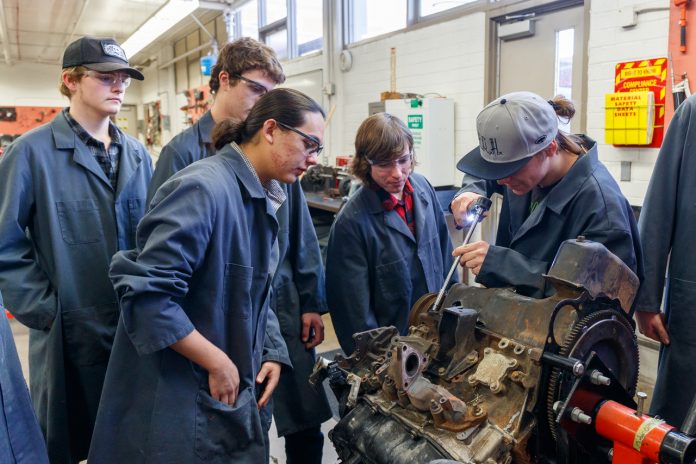A dozen teenagers stood around a mangled engine. A hole cut straight through the metal, and the oil pan was twisted from its normal shape. While one boy held a wrench, trying to take off the pan by removing screws holding it in place, another held a hammer, trying to pry the pan loose.
Eventually it came off, joined by a spew of oil.
“Did you get it on you?” one student asked.
“Uh, well …” said another, clearly not minding the black liquid that had gotten on the long gray jacket he wore over his school clothes, the uniform of those working in the auto shop.
Under the oil pan, the inside of the engine — pulled out of a 2001 Nissan Frontier that had been donated to the Mingus Union High School auto shop — looked even worse than the outside. Entire crankshafts came apart, mangled, bent and broken.
“This is some of the best destruction I’ve ever seen,” auto teacher Andy Hooton said. “This is why you keep your engine well-oiled.”
When Hooton was in high school, his heavy dyslexia made him do badly in classes. A counselor told him, “Kids like you don’t go to college,” and he ended up apprenticing with an auto dealer instead. After getting certified as a mechanic and working for various auto shops as well as General Motors and Chrysler, Hooton eventually did go to college, and studied to become a high school teacher. Though he once taught social studies, for the past five years he has taught students how to fix cars, just like he did.
“They like it, they want the college credit, they want the experience,” Hooton said of the students in his class. “Some of them, this is their path to the future. They see opportunity that they wouldn’t have otherwise. Some of them don’t really like school and don’t want to go to four years of college, and sometimes they look at [other students who have gone through the program] and they think I can make a living too, and I don’t have to do anything more than this. I can do this and then have options.”
The school has a fleet of 22 cars, all donated by owners after they became not worth the money to repair. Donors get a tax credit, and, when they get cars that have serious problems in their inner workings, the Mingus students get a chance to see all the different things that can go wrong and learn how to fix them.
“I’ve been interested in cars since I was like 10,” Owen Jones, a Mingus junior said. Jones said that the class on auto repair “makes me think of them in much more of a monetary sense. Not only can I have fun, I can make money too.”
The class provides students with training to be able to take and hopefully pass the Entry- Level Certification test with the National Institute of Automotive Service Excellence, opening students up to be able to work in any shop that will hire them. But beyond simply teaching the skills, the program sends students to go apprentice with auto shops around town, giving them a chance to work on the next level of certification, available after two years of apprenticeship.
Helaine Kurot of 360 Automotive has been taking apprentices from the Mingus auto class for three years. She said that she sees the apprentices as 60% work and 40% training, but praised the skill of those who come to work in her shop.
“You tell them to replace a part and they can do that.A lot of it is just training the diagnostics and how I want inspections done and that kind of thing,” Kurot said. “They pretty much do anything anyone else would do if they came in. Some days it takes a little longer than others but for the most part, they keep up. There’s no attitude. There’s no ego. They want to learn.”
“I’ve learned a lot from Helaine. She has showed me how to work on some basic stuff,” Alitzel Ortiz, one of Kurot’s apprentices, wrote in an email. “Removing spark plugs, etc. It’s different for me because if you mess up it’s not a thing you can change later. Everything has consequences if you make a mistake.”
“It’s huge,” Kurot wrote. “A lot of other shop owners I’m friends with from around the country don’t have programs like this, and so for them to find another tech or train another tech is almost impossible.”



